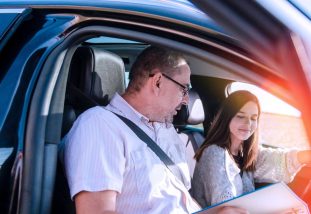A car accident can happen to anyone at any moment. Here are some tips from our broker that will help you get through this situation more easily.
1. STAY CALM.
In this context, it is very likely that you will feel scared, panicked, or even angry. It is important to take time to breathe in order to know what to do next.
You should first check whether all the passengers in your vehicle are unharmed and reassure them. If anyone is injured, call 911 as soon as possible, so that an ambulance can come to the site of the accident. The police will also automatically be informed of the accident and can come to the site.
Some accidents involve another car, and therefore another person (or more than one) who is also experiencing a range of emotions that may not usually be experienced by the person. If the person insults or threatens you, stay in your car and wait for the police.
2. CLEAR THE AREA.
If those involved in the accident are not in danger, move to the right of the roadway, especially if you are on a highway, bridge, or other busy roadway. In doing so, you will prevent other accidents, and traffic flow can return to normal.
3. IDENTIFY YOURSELF.
When the police arrive at the scene of the accident, it is their duty to fill out an accident report. You must provide the police officer with
- your driver’s licence;
- your vehicle registration; and
- your proof of insurance.
The police officer will then interview the drivers involved and/or the witnesses to determine what happened.
The police officer will also provide you with a report number that you can give to your insurer during the claims process.
4. FILL OUT A JOINT REPORT.
There may be times when the situation does not require the presence of a police officer. In such cases, you can complete a joint report. It is also possible that you can exchange the following information with the other driver:
- Full name;
- Civic address;
- Phone number;
- Licence plate number; and
- Insurance policy number and the name of the policyholder.
You can also make an appointment later in the day to complete the report. That being said, exchanging information is sufficient.
Tip: If you have a cell phone, take pictures of the documents (licence, licence plate, etc.) or ask to see them with your own eyes, because unfortunately some people provide false information, and it will be impossible to find them afterwards.
If the accident was a hit-and-run, it is preferable to have a police report. However, in some municipalities, police officers are no longer dispatched in such situations. To learn more about what to do in the event of a hit-and-run, read this article written by our damage insurance brokers.
5. CONSIDER HAVING YOUR VEHICLE TOWED.
If your car needs to be towed, it is important to note that it will be brought to an auto repair shop close to the site of the accident. If your damage is covered by your insurance policy, towing costs will be covered by your insurer. Afterwards, your assigned claims adjuster will be responsible for following up. If, however, you are able to get your car back on the road, you can drive it when you have finished up the process with the police.
6. NOTIFY YOUR INSURANCE BROKER.
It is very important to notify your insurer about the situation as soon as possible. Your insurer will ask you for your version of the facts related to the accident, information about the other driver, and the joint report or the police report number. It will contact the other driver involved to learn that driver’s version of the facts. It will then be the duty of the insurer to put you in the same situation you were previously in, whether by ensuring that your vehicle gets repaired, or if it cannot be repaired, by providing you with a monetary sum.
PREVENTING ACCIDENTS
While accidents come as (unpleasant) surprises, it is possible to adjust some of our actions to prevent them. Here are some simple tips that are often forgotten to ensure that you have peace of mind when you are behind the wheel:
- Avoid going out during storms.
- Do not get too close to the car in front of you while you are driving.
- Respect speed limits.
- Do not drink alcohol or use drugs if you are driving.
- Make sure that your headlights and brake lights are all functional.
- Avoid braking suddenly or at the last minute.
- Make full stops (at stop signs and traffic lights).
- Clear off snow from your car and remove ice from windows and windshields.
- Drive with others in mind—they may also be distracted!
Stay safe!



